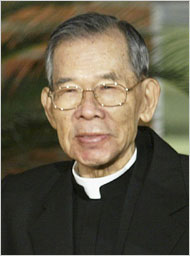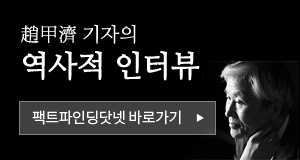| 뉴욕타임즈 訃告란에 실린 金壽煥 추기경 他界소식 |

뉴욕타임즈에 실린 김추기경 사진
안타깝게도 처음부터 끝까지 “韓國의 암울했던 군사독재시절의 先導者”라는 말로 시작해서 끝나는 기사였다. 한국에 대해서 잘 모르는 사람이 이 글을 읽었다면, “한국의 現代史는 어둡기만한 군사독재의 연속이었며, 그러므로 한국의 現代史에는 긍정적인 면이 하나도 없겠구나. 이 김추기경이라는 사람은 그 못된 독재랑 싸웠으니 훌륭하구나. 한국은 그저 三流 독재국가인가 보구나 ” 라는 생각이 들지 않았을까 걱정이 될 정도였다.
기사의 어느 부분도, 군사정권이 일으킨 경제력과 , 김추기경님과 같이 자유와 민주를 사랑하는 힘이 합해져서 오늘의 자유대한민국이 있음을 暗示하지 않고 있다. 또한 김추경님이 민주화 이후에는, “민주화”의 탈을 쓰고 김정일 독재에 머리를 조아리는 가짜민주세력에게 철퇴를 날리시며 “대한민국의 헌법은 자유민주주의에 입각한 통일을 하도록 우리에게 命하고 있으며, 자유민주주의를 훼손하는 어떠한 통일방식에도 나는 동의할 수 없다” 못박으신 김추기경님의 모습을 묘사하지 않고 있다.
正常的인 自由大韓民國의 國民이었다면, 군사독재가 끝나고 민주화가 이루어진 후에는 應當,“자, 이제는 저 暴惡한 독재아래 시달리는 북녘동포를 구할 차례이다. 鴨綠江까지 自由民主主義의 태극깃발이 휘날릴때 진정으로 우리의 “民主化'소원은 이루어 지는 것이 아닌가” 라고 두 주먹 불끈 쥐어야 했을 것이다. 그리고 自由統一로 방향을 잡았어야 순서가 제대로 되는 것이었다. 그런데 그렇지가 못했다. 김추기경님이 위대한 것은, 한국의 독재와 싸웠기 때문이기도 하지만, 민주화가 이루어 진 이후에 많은 사람들이 비정상적인 생각과 행동을 하고, 잘못된 방향으로 나아가고 있을때, 그 잘못된 사태를 비판하며, 한 사람의 자유민주국가의 국민으로서 지극히 정상적으로 사고하고 행동하며 성직자 생활을 하셨기 때문일 것이다. 안타깝게도 뉴욕타임즈의 訃告는 김추기경님의 이러한 위대함을 드러내지 못했다.
뉴욕타임즈의 아시아/한국 특파원으로 보이는 Choe Sang-Hun 이라는 기자가 쓴 것인데, 아무리 뉴욕타임즈가 소위 미국의“진보”를 대변하는 신문이며, 편집방향도 “liberal”한 쪽으로 기우는 신문이라지만, 이 기사는 좀 너무하지 않았나 싶다. 뉴욕타임즈가 “자유”와 “민주”와 “인권”을 그리도 소중한 가치로 여기는데, 이미 끝난 한국의 군사독재랑 싸운것만 김추기경님의 업적인냥 그릴것이 아니라, 북한의 김부자의 독재와 그의 추종자들과 싸운것도 업적으로 그렸어야 신문사의 편집취지에 더 어울리지 않았을까하는 생각이 든다.
여기에 뉴욕타임즈 訃告 原文을 실어 본다.
February 17, 2009
Stephen Kim Sou-hwan, Cardinal, Dies at 86
By CHOE SANG-HUN
SEOUL, South Korea — Cardinal Stephen Kim Sou-hwan, South Korea’s first Roman Catholic cardinal, to whom Catholic and non-Catholic South Koreans turned for consolation and support during the era of military dictatorship from the 1960s through the 1980s, died Monday. He was 86.
Cardinal Kim died at St. Mary’s Hospital in Seoul, said Lee Hee-yeon, an official with the Archdiocese of Seoul, according to The Associated Press.
From the pulpit of Myeongdong Cathedral in central Seoul, Cardinal Kim boldly criticized the military dictators who governed South Korea for three decades. He dismissed what he described as their “despotic” rule, and he advocated fearlessly for democracy. Pope Benedict XVI said he was deeply saddened by the death of Cardinal Kim, who was the longest-serving cardinal and a beloved spiritual leader in South Korea.
President Lee Myung-bak, a Protestant, called Cardinal Kim’s death “a great loss to the nation.” Chung Se-kyun, head of the Democratic Party, the main opposition, called the cardinal “a big guiding star in our nation’s modern history.”
Cardinal Kim was archbishop of Seoul from 1968 until 1998, and he was also in charge of the Diocese of Pyongyang in North Korea from 1975 until 1998. He regretted that he was never able to travel to Pyongyang, once a center of Christianity in the Korean Peninsula, because the Communist government there opposed a visit.
He was born in 1922 in Daegu, in central South Korea, and was the youngest of eight children. His father was a crockery salesman and his grandfather, a convert to Catholicism, died in prison during bloody persecutions of Catholic converts in Korea during the 19th century.
He was ordained in 1951 during the Korean War and was named a cardinal by Pope Paul VI in 1969.
During his time as cardinal, the number of Catholics in South Korea increased more than sixfold. But his influence went beyond the nation’s five million Catholics.
When South Korea’s authoritarian leaders tolerated, if not encouraged, the kidnapping and torturing of dissidents and the beating and jailing of students calling for democracy, Cardinal Kim was often a lone voice opposing the brutality. He became a moral force whose support was sought by dictators and opposition leaders.
When President Chun Doo-hwan visited him shortly after taking power in a military coup in 1979, the cardinal chastised him, comparing his illegal seizure of the government to “an outlaw gunfight in a Western movie.”
The Myeongdong Cathedral served for decades as a haven for student activists, migrant workers and labor leaders, among others. “You can step on me, then the priests and nuns behind me, before you can take away the students,” he told a police chief in 1987 when Mr. Chun’s government sought to arrest student activists seeking refuge in the cathedral.
“Cardinal Kim’s presence among us was a great consolation during the harshest time of our nation,” said Cardinal Nicholas Cheong Jin-suk, the archbishop of Seoul.


















